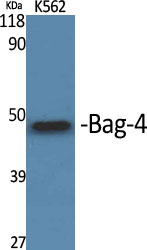Bag-4 Polyclonal Antibody
- Catalog No.:YT0441
- Applications:WB;IHC;IF;ELISA
- Reactivity:Human;Mouse;Rat
- Target:
- Bag-4
- Fields:
- >>TNF signaling pathway
- Gene Name:
- BAG4
- Protein Name:
- BAG family molecular chaperone regulator 4
- Human Gene Id:
- 9530
- Human Swiss Prot No:
- O95429
- Mouse Gene Id:
- 67384
- Mouse Swiss Prot No:
- Q8CI61
- Immunogen:
- Synthesized peptide derived from the C-terminal region of human Bag-4.
- Specificity:
- Bag-4 Polyclonal Antibody detects endogenous levels of Bag-4 protein.
- Formulation:
- Liquid in PBS containing 50% glycerol, 0.5% BSA and 0.02% sodium azide.
- Source:
- Polyclonal, Rabbit,IgG
- Dilution:
- WB 1:500 - 1:2000. IHC 1:100 - 1:300. ELISA: 1:40000.. IF 1:50-200
- Purification:
- The antibody was affinity-purified from rabbit antiserum by affinity-chromatography using epitope-specific immunogen.
- Concentration:
- 1 mg/ml
- Storage Stability:
- -15°C to -25°C/1 year(Do not lower than -25°C)
- Other Name:
- BAG4;SODD;BAG family molecular chaperone regulator 4;BAG-4;Bcl-2-associated athanogene 4;Silencer of death domains
- Observed Band(KD):
- 50kD
- Background:
- The protein encoded by this gene is a member of the BAG1-related protein family. BAG1 is an anti-apoptotic protein that functions through interactions with a variety of cell apoptosis and growth related proteins including BCL-2, Raf-protein kinase, steroid hormone receptors, growth factor receptors and members of the heat shock protein 70 kDa family. This protein contains a BAG domain near the C-terminus, which could bind and inhibit the chaperone activity of Hsc70/Hsp70. This protein was found to be associated with the death domain of tumor necrosis factor receptor type 1 (TNF-R1) and death receptor-3 (DR3), and thereby negatively regulates downstream cell death signaling. The regulatory role of this protein in cell death was demonstrated in epithelial cells which undergo apoptosis while integrin mediated matrix contacts are lost. Alternatively spliced transcript variants encoding distinct
- Function:
- function:Inhibits the chaperone activity of HSP70/HSC70 by promoting substrate release (By similarity). Prevents constitutive TNFRSF1A signaling.,similarity:Contains 1 BAG domain.,subunit:Binds to the ATPase domain of HSP70/HSC chaperones. Binds to the death domain of TNFRSF1A in the absence of TNF and thereby prevents binding of adapter molecules such as TRADD or TRAF2. Binds to the death domain of TNFRSF12.,tissue specificity:Ubiquitous.,
- Subcellular Location:
- Cytoplasm.
- Expression:
- Ubiquitous.
- June 19-2018
- WESTERN IMMUNOBLOTTING PROTOCOL
- June 19-2018
- IMMUNOHISTOCHEMISTRY-PARAFFIN PROTOCOL
- June 19-2018
- IMMUNOFLUORESCENCE PROTOCOL
- September 08-2020
- FLOW-CYTOMEYRT-PROTOCOL
- May 20-2022
- Cell-Based ELISA│解您多样本WB检测之困扰
- July 13-2018
- CELL-BASED-ELISA-PROTOCOL-FOR-ACETYL-PROTEIN
- July 13-2018
- CELL-BASED-ELISA-PROTOCOL-FOR-PHOSPHO-PROTEIN
- July 13-2018
- Antibody-FAQs
- Products Images

- Western Blot analysis of various cells using Bag-4 Polyclonal Antibody
.jpg)
- Western Blot analysis of K562 cells using Bag-4 Polyclonal Antibody

- Immunohistochemical analysis of paraffin-embedded human tonsil. 1, Antibody was diluted at 1:200(4° overnight). 2, Tris-EDTA,pH9.0 was used for antigen retrieval. 3,Secondary antibody was diluted at 1:200(room temperature, 30min).



